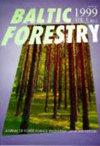波罗的海东南部产地苏格兰松径向增量的遗传和环境变异对极端天气的响应
IF 0.7
4区 农林科学
Q3 FORESTRY
引用次数: 0
摘要
气候反常现象的加剧,特别是与冬季变暖时的气温和水分供应有关的反常现象,已被确定为对半北纬地区森林生态系统的主要新气候威胁。考虑到这些威胁的大规模性质,协助迁移和树木繁育似乎是减轻气候风险的最有希望的手段。然而,要成功实施这些手段,需要了解树木对气候敏感性的遗传控制信息。种群的局部遗传适应会最大限度地提高竞争力和存活率,而表型可塑性的差异则意味着不同基因型与环境的相互作用,可以利用这种差异获得有针对性的局部繁殖材料。为了初步(粗略)估算基因控制和表型可塑性对气候异常的生长反应,研究人员在拉脱维亚和德国北部的五个试验中,对七个东波罗的海本地产地的生产力差异进行了研究。每个试验的每个产地测量了 10-15 棵树的树环宽度。通过计算相对生长变化和指针年值,将增量变化与天气异常联系起来,并采用数量遗传学方法估算每年的遗传率。在分析期间(1987-2017 年),估计了四到七个试验和原产地特有的指针年(常见的相对生长变化),这些指针年主要是由水分供应和冬季热量机制的共同异常触发的。这意味着所研究的树木对单一天气异常的适应能力很强,表明其适应性很强。此外,遗传力估计值在指针年后的一到两年达到峰值,这意味着生长恢复以及恢复力而非抗性是受遗传控制的。尽管如此,指针年和遗传力估计值的局部变异性还是反映了反应的明显表型可塑性,这意味着育种有可能在局部提高生长的耐气候性:欧洲赤松;本地适应;表型可塑性;生长恢复;树环宽度;指针年数本文章由计算机程序翻译,如有差异,请以英文原文为准。
The genetic and environmental variance of radial increment in Scots pine of south-eastern Baltic provenances in response to weather extremes
Intensification of weather anomalies, particularly those related to temperature in warming winters and moisture availability, have been identified as the major emerging climatic threats to forest ecosystems in the hemiboreal zone. Considering the large-scale nature of the threats, assisted migration and tree breeding appear as the most promising means for mitigating the climatic risks. However, for successful implementation of such means, information on the genetic control over the weather sensitivity of trees is needed. Local genetic adaptations of populations occur to maximize competitiveness and survival, while the differences in phenotypic plasticity, implying varying genotype by environmental interactions, can be utilized for the acquisition of locally targeted reproductive material. To gain initial (rough) estimates of genetic control and phenotypic plasticity of growth responses to weather anomalies, a set of seven native eastern Baltic provenances differing by productivity in five trials in Latvia and northern Germany were studied. Tree-ring widths were measured for 10–15 trees per provenance per trial. Relative growth changes and pointer year values were calculated to link changes in increment with weather anomalies and to estimate heritability on an annual basis by the methods of quantitative genetics. During the analysed period (1987–2017), four to seven trial- and provenance-specific pointer years (common relative growth changes) were estimated, which were mainly triggered by co-occurring anomalies in moisture availability and winter thermal regime. This implied resilience of the studied trees to singular weather anomalies, suggesting their adaptability. Furthermore, the heritability estimates peaked one to two years after the pointer years, implying that growth recovery and hence resilience rather than resistance was genetically controlled. Still, local variability of pointer years and heritability estimates portrayed explicit phenotypic plasticity of responses, implying the potential for breeding to locally improve weather tolerance of growth.
Keywords: Pinus sylvestris; local adaptation; phenotypic plasticity; growth recovery; tree-ring width; pointer years
求助全文
通过发布文献求助,成功后即可免费获取论文全文。
去求助
来源期刊

Baltic Forestry
农林科学-林学
CiteScore
1.60
自引率
0.00%
发文量
23
审稿时长
>12 weeks
期刊介绍:
The journal welcomes the original articles as well as short reports, review papers on forestry and forest science throughout the Baltic Sea region and elsewhere in the area of boreal and temperate forests. The Baltic Sea region is rather unique through its intrinsic environment and distinguished geographical and social conditions. A temperate climate, transitional and continental, has influenced formation of the mixed coniferous and deciduous stands of high productivity and biological diversity. The forest science has been affected by the ideas from both the East and West.
In 1995, Forest Research Institutes and Universities from Estonia, Latvia and Lithuania
joined their efforts to publish BALTIC FORESTRY.
 求助内容:
求助内容: 应助结果提醒方式:
应助结果提醒方式:


